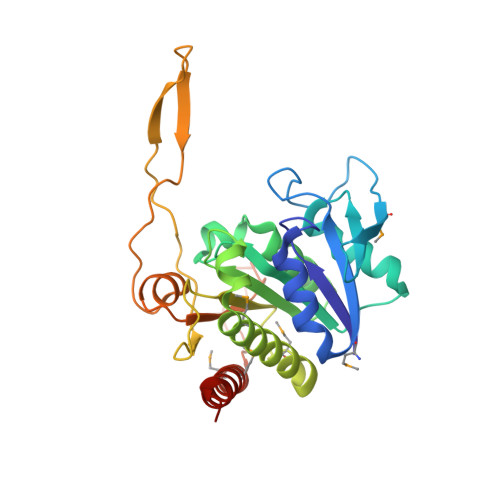Structure and Function of an Archaeal Homolog of Survival Protein E (SurE-alpha): An Acid Phosphatase with Purine Nucleotide Specificity
Mura, C., Katz, J.E., Clarke, S.G., Eisenberg, D.(2003) J Mol Biol 326: 1559-1575
- PubMed: 12595266
- DOI: https://doi.org/10.1016/s0022-2836(03)00056-1
- Primary Citation of Related Structures:
1L5X - PubMed Abstract:
The survival protein E (SurE) family was discovered by its correlation to stationary phase survival of Escherichia coli and various repair proteins involved in sustaining this and other stress-response phenotypes. In order to better understand this ancient and well-conserved protein family, we have determined the 2.0A resolution crystal structure of SurEalpha from the hyperthermophilic crenarchaeon Pyrobaculum aerophilum (Pae). This first structure of an archaeal SurE reveals significant similarities to and differences from the only other known SurE structure, that from the eubacterium Thermatoga maritima (Tma). Both SurE monomers adopt similar folds; however, unlike the Tma SurE dimer, crystalline Pae SurEalpha is predominantly non-domain swapped. Comparative structural analyses of Tma and Pae SurE suggest conformationally variant regions, such as a hinge loop that may be involved in domain swapping. The putative SurE active site is highly conserved, and implies a model for SurE bound to a potential substrate, guanosine-5'-monophosphate (GMP). Pae SurEalpha has optimal acid phosphatase activity at temperatures above 90 degrees C, and is less specific than Tma SurE in terms of metal ion requirements. Substrate specificity also differs between Pae and Tma SurE, with a more specific recognition of purine nucleotides by the archaeal enzyme. Analyses of the sequences, phylogenetic distribution, and genomic organization of the SurE family reveal examples of genomes encoding multiple surE genes, and suggest that SurE homologs constitute a broad family of enzymes with phosphatase-like activities.
Organizational Affiliation:
Howard Hughes Medical Institute and UCLA-DOE Institute for Genomics and Proteomics, Molecular Biology Institute, 201 Boyer Hall, Box 951570, Los Angeles, CA 90095-1570, USA.

















